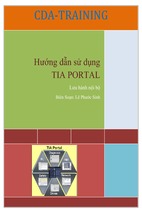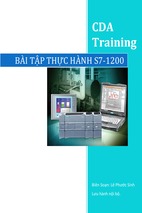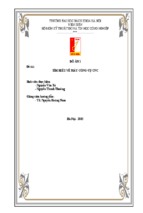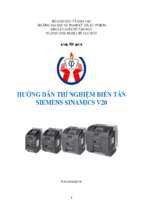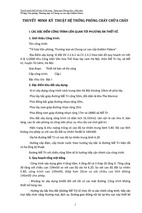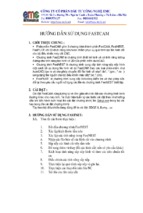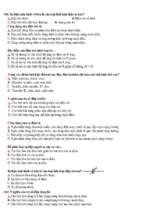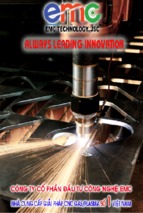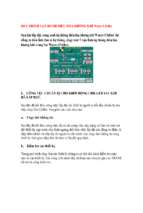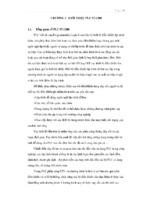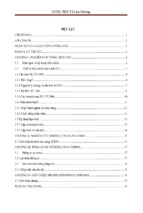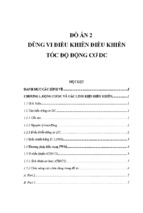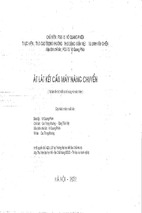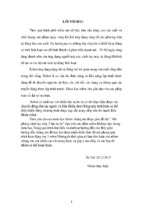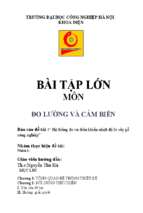Mô tả:
Predetermined Time Standards
Work and Time Studies
Vietnamese German University
Dr.-Ing. Marlene Helfert
2016
Dr.-Ing. Marlene Helfert | Work and Time Studies | 2016 | 1
Predetermined time standards
Contents
Predetermined time standards
Methods–Time Measurement (MTM)
MTM-1
MTM-2
MTM-3
MTM-V
MTM-C
MTM-M
Specialized MTM systems
Dr.-Ing. Marlene Helfert | Work and Time Studies | 2016 | 2
Predetermined time standards
Contents
Predetermined time standards
Methods–Time Measurement (MTM)
MTM-1
» MTM-1 analysis
» MTM-1 basic motions
» MTM-1 simultaneous motions
» MTM-1 coding
• Coding “reach”
• Coding “grasp”
• Coding “move”
• Coding “position”
• Coding “release”
» Exercise
Dr.-Ing. Marlene Helfert | Work and Time Studies | 2016 | 3
Predetermined time standards
Predetermined time standards (PTS)
Methods to break down manual, worker influenced
workflows in motion elements and assign standard time
values to them
Aim at defining the time needed for operations by derivation
from preset standards of time for various motions without
direct observation and measurement.
Derived as a result of studying a large sample of diversified
operations
Times established for basic human motions (classified
according to the nature of the motion and the conditions
under which they are done) are used to build up the time for a
job at defined levels of performance
Also called predetermined motion-time systems (PMTS)
Bruder 2012
Salvendy 2001
Dr.-Ing. Marlene Helfert | Work and Time Studies | 2016 | 4
Predetermined time standards
Example of use: Operation of electrical switches
Analysis using MTM 1
Schlick 2005
Dr.-Ing. Marlene Helfert | Work and Time Studies | 2016 | 5
Predetermined time standards
Comparison of different tools for turning a screw
Screws are isolated with means
of an oscillating grate
Hand
Supply: Manual
Time required: 100%
Hand
Supply: Manual
Time required: 80%
Britzke et al. 1989
Dr.-Ing. Marlene Helfert | Work and Time Studies | 2016 | 6
Predetermined time standards
Applications of PTS
Design of the working
system
• Planning of the
operation process
• Optimization of the
operating process
• Design of tools and
equipment
• Design of the
manufacture
Time determination
Work instruction
• Formation of planned
times
• Determination of
standard time for
performance-related
remuneration
• Pre-costing
• Description of the
operating processes for
education and
instruction materials
Schlick 2005
Dr.-Ing. Marlene Helfert | Work and Time Studies | 2016 | 7
Predetermined time standards
Advantages
Determination of execution times already in the planning
phase
Permits establishing methods and standards in advance of
actual production
Employees can already be trained previous to the
implementation of a new operating process
Optimization of work processes
No performance assessment of the workers is needed
Forces detailed and accurate descriptions of the workplace
layout; motion patterns; and shape, size, and fit of
components and tools
Permits easy and accurate adjustments of time standards to
accommodate minor changes in method
Deutsche MTM-Vereinigung
Salvendy 2001
Dr.-Ing. Marlene Helfert | Work and Time Studies | 2016 | 8
Predetermined time standards
Disadvantages
The analysis effort is relatively high
For the PTS analysis trained personnel is needed
Depends on complete and accurate descriptions of the
required methods for the accuracy of the time standard
More difficult to explain to workers and supervisors
Must use stopwatch or standard data for process-controlled
and machine-controlled elements
Deutsche MTM-Vereinigung
Salvendy 2001
Dr.-Ing. Marlene Helfert | Work and Time Studies | 2016 | 9
Predetermined time standards
Historic milestones in the development of PTS
Schlick 2005
Dr.-Ing. Marlene Helfert | Work and Time Studies | 2016 | 10
Predetermined time standards
PTS systems
Sets of motion–time tables with explanatory rules and
instructions on the use of the motion–time values
Considerable training is required to earn certification before
analysts are allowed to apply the Work-Factor, MTM, or MOST
systems
Differences
Levels and scope of application of data
Motion classification
Time units
Adding contingency allowances or not
Scope of application
Universal or generic
Functional
Specific
Salvendy 2001
Dr.-Ing. Marlene Helfert | Work and Time Studies | 2016 | 13
Predetermined time standards
Universal systems
Designed for body members in general
Application is not restricted to any specific type of work
Motion descriptions only identify the body member being
used
Use generic terms like reach, transport, grasp, walk
Examples of universal systems
MTM-1 to MTM-3
Work-Factor
MOST
MODAPTS
Salvendy 2001
Dr.-Ing. Marlene Helfert | Work and Time Studies | 2016 | 14
Predetermined time standards
Functional systems
Define motion element times for a particular type of activity,
e.g.
Clerical work (MTM-C)
Uses of microscopes (MTM-M)
The element names indicate the function for which the system
was developed, e.g. FILE is a common element name in office
work environments
Salvendy 2001
Dr.-Ing. Marlene Helfert | Work and Time Studies | 2016 | 15
Predetermined time standards
Specific systems
Motion–time tables constructed for specific operations or
work areas, e.g.
Standard motion–time tables for electronic tests (MTM-TE)
Measurement of one-of-a-kind and small-lot production
(MTM-MEK)
Salvendy 2001
Dr.-Ing. Marlene Helfert | Work and Time Studies | 2016 | 16
Methods–Time Measurement (MTM)
MTM Association
Established in 1951 with the purpose to promote the use
of MTM-based work measurement in industry
Research by the MTM Association and its sister organizations
has led to the continual expansion of the family of MTM
analysis tools in use today.
Nowadays, more than 30 MTM Associations around the world
provide training, certification, and software. These non-profit
associations are all part of the International MTM Directorate
(IMD).
MTM became the first widely used predetermined time
system. Over 80% of all work standards developed with a
predetermined time analyzing system are developed with
MTM systems.
MTM Association 2016
Dr.-Ing. Marlene Helfert | Work and Time Studies | 2016 | 17
Methods–Time Measurement (MTM)
MTM Systems
The original MTM system is now known as MTM-1
Subsequent modifications to provide easier and quicker
systems by condensing and reducing the number of motion
options and time values:
MTM-2 and MTM-3 are examples of second-level and thirdlevel MTM data
In addition, the MTM family of systems include
MTM-V
MTM-C
MTM-M
MTM-TE
MTM-MEK
MTM-UAS
Salvendy 2001
Dr.-Ing. Marlene Helfert | Work and Time Studies | 2016 | 18
MTM-1
Fundamental motions
REACH
MOVE
TURN
GRASP
POSITION
DISENGAGE
RELEASE
Salvendy 2001
Dr.-Ing. Marlene Helfert | Work and Time Studies | 2016 | 19
MTM-1
Fundamental motions
Some fundamental motions are categorized into different
distinct cases, based on factors that affect motion times, such
as distance, weight of the object, and type of motion:
5 cases of REACH
3 cases of MOVE
2 cases of RELEASE
18 cases of POSITION
Salvendy 2001
Dr.-Ing. Marlene Helfert | Work and Time Studies | 2016 | 20
MTM-1
Application of the MTM basic method (MTM-1)
Mass production in large batches
Limited model variety
Short-cycle processes
Exactly defined basic conditions
Experienced, highly trained employees
Workstations designed with focus on detail
Deutsche MTM-Vereinigung
Dr.-Ing. Marlene Helfert | Work and Time Studies | 2016 | 21
MTM-1
The tabulated values do not include any allowances
Proponents of the MTM-1 system state
that recovery times are not needed in
most applications because the time
values are based on a work rate that can
be sustained at steady state for the
working life of a healthy employee.
Salvendy 2001
Dr.-Ing. Marlene Helfert | Work and Time Studies | 2016 | 22
- Xem thêm -

